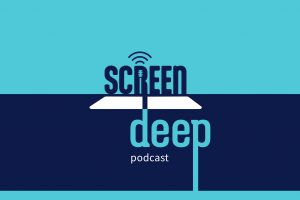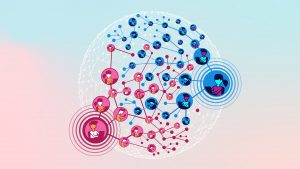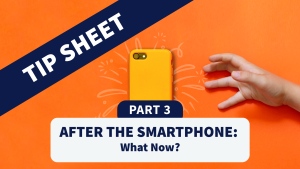Adolescence is an exciting period of life shaped by risks, rewards, and rapid changes in the brain. On this episode of Screen Deep, host Kris Perry and guest Eva Telzer (Professor of Psychology and Neuroscience at University of North Carolina at Chapel Hill and Co-Director of the Winston National Center on Technology Use, Brain, and Psychological Development) explore how and why adolescents use digital media differently and the potential impact it may have on their developing brains.
An expert on adolescent neuroscience, behavior, and media use, Dr. Telzer discusses insights from her large and growing body of research, including multi-year projects investigating the dynamic relationship between teens’ social media use and the makeup of their brain. How does social media trigger the reward system of the brain? Can teens’ habitual smartphone behaviors impact their developing brains? Are some teens more prone to problematic smartphone use than others? Tune in to hear how Telzer’s research helps answer these questions.
Listen on Platforms
About Eva Telzer
 Eva Telzer is a Professor of Psychology and Neuroscience at UNC Chapel Hill and the Co-Director of the Winston National Center on Technology Use, Brain and Psychological Development. Her research examines how social and cultural processes shape adolescent brain development, with a focus on both prosocial and risk-taking behaviors, family and peer relationships, and the role of social media in youth’s lives. She has authored over 200 publications and has received numerous awards for her work including an Association for Psychological Science Rising Star Award, an early career award from the Society of Research on Adolescence, a Young Investigator Award from the Flux Congress Society for Developmental Cognitive Neuroscience, and the American Psychological Association Distinguished Scientific Award for Early Career Contribution to Psychology. She is regularly featured as an expert in psychological science in consultation to government agencies and non-profit associations as well as media appearances in The New York Times, NPR, CNN, ABC, CBS, and NBC.
Eva Telzer is a Professor of Psychology and Neuroscience at UNC Chapel Hill and the Co-Director of the Winston National Center on Technology Use, Brain and Psychological Development. Her research examines how social and cultural processes shape adolescent brain development, with a focus on both prosocial and risk-taking behaviors, family and peer relationships, and the role of social media in youth’s lives. She has authored over 200 publications and has received numerous awards for her work including an Association for Psychological Science Rising Star Award, an early career award from the Society of Research on Adolescence, a Young Investigator Award from the Flux Congress Society for Developmental Cognitive Neuroscience, and the American Psychological Association Distinguished Scientific Award for Early Career Contribution to Psychology. She is regularly featured as an expert in psychological science in consultation to government agencies and non-profit associations as well as media appearances in The New York Times, NPR, CNN, ABC, CBS, and NBC.
In this episode, you’ll learn:
- Why social reward cues (likes, comments, etc) have a unique impact on the developing adolescent brain.
- How research utilizing functional MRI is expanding our knowledge about changes in the brains of adolescents habitually engaging in social media use.
- What neurological factors put some teens at a higher risk for problematic social media use than others.
- How research dispels popular stereotypes of adolescents as high risk takers and dependent on peer influence.
- How the reward system in the brain works and ways it can be redirected for positive social behaviors and connections online by adolescents.
[Kris Perry] Hello and welcome to the Screen Deep podcast where we go on deep dives with experts in the field who are searching for answers to the complex questions surrounding the developing mind, body, and future of children as they navigate a digital world. I’m Kris Perry, Executive Director of Children and Screens and the host of Screen Deep. Today, I welcome our guest, Dr. Eva Telzer, a giant in the field of adolescent neuroscience, behavior, and media use. Eva is a professor of psychology and neuroscience at UNC Chapel Hill, co-director of the Winston National Center on Technology Use, Brain, and Psychological Development, and has authored over 200 journal articles in the field. Her research provides crucial insights into the interaction between adolescent brain chemistry and social media use, shedding light on how they influence each other. I’m thrilled for her to share her knowledge with you. Welcome to Screen Deep, Eva.
[Dr. Eva Telzer] Thank you, I’m excited to be here.
[Kris Perry] Out of curiosity, I’d like to ask you and all of our guests on this podcast, how much time do you spend on screens a day? And do you feel like you spend too much time on screens?
[Dr. Eva Telzer] You’re getting deep from the first question! Well, my entire job is basically behind a screen. So I spend most of my workday behind a screen, either working or engaging in conversations with people who I can’t be face to face with, so a big chunk of my workday is behind a screen. And my non -workday, it’s really hard to quantify. And I think that this is a research question in itself of being able to actually recall and know how much time you spend on your screen. I would say it’s probably a couple of hours and it has reduced since having my own child because now when I get home I’m mostly interacting with a toddler and not sitting behind a screen either doing something social or doing more work or watching television. So my time has definitely decreased since having a kid.
[Kris Perry] I’d like to take the conversation to your research and to the science and actually just have you describe your focus and what you’ve been studying primarily throughout your career.
[Dr. Eva Telzer] Sure, so I’ve always been fascinated by the adolescent years. So from my college years into my post-bac years into grad school and now as a professor, I’ve always been fascinated by the adolescent period, pretty generally speaking. How is it that we become who we are? How do the experiences we have in our adolescent years affect us? The social context in particular has been very interesting to me. It started off largely focused on the family context early in my career, shifting more to the peer context later in my career, and now is really focusing on the social media context because a lot of adolescents’ social experiences are occurring via social media. And so I’m just very fascinated by how all of these different social experiences, whether it’s in person or digitally with peers and family and the broader social milieu–how this impacts the developing adolescent. I take a neuroscience perspective to these questions to understand the developing brain because adolescence is a period when the brain is undergoing rapid developmental changes. It’s very sensitive to the social context and really being able to understand how these social contexts are impacting the developing brain is my key interest and research focus.
[Kris Perry] I’m glad you brought up that sensitivity in the adolescent developmental stage, and I just wanted you to talk a little bit more about why you’ve focused so exclusively on them. Is it because of that sensitivity or are there other aspects of the adolescent brain that are unique that have drawn you to that area of study?
[Dr. Eva Telzer] Yeah, so adolescence, second only to really early postnatal development, is a period of rapid brain growth more so than pretty much any other developmental period other than, you know, those really early changes that are happening in early postnatal development. And until only a few decades ago we didn’t know this. Neuroscience research, and in particular functional magnetic resonance imaging, has allowed us to look inside the developing brain – see how it is changing and growing during these developmental periods. And so because of that developmental change in the brain, it’s very plastic. That means it can change and be shaped by its environment. And so I’m just really fascinated by these changes and how that might impact and sort of set the stage for lifelong development into adulthood when we know the brain is less plastic, less likely to change and develop and be responsive to its environment.
[Kris Perry] So as a lay person, I know a fair amount about child development in general and particularly early childhood. And so I’m really excited about our conversation today about adolescents and how susceptible they may be to certain risks. And now I wanted to take our conversation more towards possible problematic or compulsive media use and how you’ve studied that and that interaction between the developing brain and digital media use and adolescence. Would love for you to talk more about that connection, that combination of factors and what you’ve learned.
[Dr. Eva Telzer] Sure, so starting with the important pieces of the developing brain, it’s a period when multiple networks in the brain are changing. And there’s three that we’ve spent a lot of time talking about in my lab. One is this network of the brain that responds to rewards. These areas of the brain become very, very sensitive in adolescence. It essentially feels good. Adolescents are extra rewarded by things that are happening in their daily lives, whether that is getting “likes” or positive feedback from peers, or more other forms of peer acceptance. These networks in the brain that respond to rewards are essentially extra-activated in the teen brain. Other areas of the brain that are really important as well are these areas that respond to the social context in general, these social cognitive regions of the brain that help adolescents to take the perspective of others – to think, “What are my peers thinking? What are my peers thinking about me?” And these areas of the brain are also becoming very responsive to the environment. Another network that we refer to as the “executive control network”, this is often thought of as the prefrontal cortex allowing adolescents to engage in executive functions that help them to resist urges, to stop engaging in some of those rewarding activities to potentially say “Okay, I’m going to put my phone down now.” And so the confluence of these three networks really make adolescents extra sensitive to their environment, and we’ve tried to understand this in the context of the social media environment. So, adolescents are exposed to this constant flow of information now on their phones through likes and followers and comments and so they’re really connected to their phones around the clock. Adolescents are constantly checking their phones, looking for updates, trying to be connected, seeing if they’re receiving likes on some of their posts. So the question is, does that type of behavior and exposure to some of these social media feeds – do adolescents who are constantly or habitually checking their phones – might this change the way that their brain is developing since we know that these networks in the brain that are responsive to all of these aspects of the social media context are extra sensitive.
[Kris Perry] I really appreciate the description of the three systems that are interacting in that adolescent period, that sensitive period, and one thing that comes to mind is some of the risk associated with screen time – and sometimes that’s the number of hours you’re on, sometimes it’s the content you’re exposed to – and whether or not … taking risk, whether it’s your online life or behavior or outside of your digital life, could you talk a little bit about adolescence and risk taking and why it’s something that is, in a sense, it’s a hallmark feature of adolescence and whether or not that it might not necessarily be bad to be engaging in activities that have some risk associated with them?
[Dr. Eva Telzer] Yeah, so your point is exactly right. Adolescence really is this hallmark period of risk taking. Oftentimes some of the first words or phrases that come to mind to describe adolescents are some of the risks that they engage in. Oftentimes those are thought to be very negative and reckless, and certainly there are lots of examples of reckless behaviors that adolescents engage in. But these same neural systems involved in reward sensitivity and social cognition and executive functions that may be driving adolescents to engage in some of those negative risks, whether that is going to a party and engaging in substance use or other types of negative risks, also are very important for adolescents to explore and learn from their environment and engage in some very positive risks, whether that is doing something potentially risky but for the benefit of making new friends, or trying out for something very challenging and difficult like a sports activity or something in school that they have the risk of not getting selected for, but taking that risk in order to engage in some behaviors that can really benefit them or even benefit society. So there’s examples of what we call prosocial risk-taking where adolescents take these huge risks in order to help society and do good things for the world that may have some personal risks associated with it but those risks in the end are very beneficial and positive.
[Kris Perry] Thank you for explaining that a little bit more because it’s easy to fall into sort of some general stereotypes about adolescents and that they’re not being careful and their brains aren’t fully developed and yet it’s a period of such – it’s magical, really, what is occurring in the brain, and then their interaction with society and these really complex decisions that they’re making in real time that will not only have – yield results right now, but over the course of their lives those risks may lead to skills and abilities later on in adulthood. It’s so exciting to think about how much of that is occurring in the child’s life at that time. So speaking of these structural changes that you mentioned earlier, I wanted to take a little bit of a deeper dive, mostly because you’ve published some recent articles on – on these structural changes. And one of those from earlier this year looked at changes in neural sensitivity to social feedback over time and how these changes relate to addictive social media use. Would you share a little bit of the key findings from that study?
[Dr. Eva Telzer] Sure, so in this study we were really interested in identifying adolescents who might be at risk for social media addiction. So social media addiction includes some of the more problematic forms of social media use: not being able to live without social media, having these urges to have social media when you don’t have it, going out of your way to have social media when you otherwise couldn’t have it. And not all adolescents are gonna develop addiction to social media, but some adolescents might be more at risk for developing social media addiction. And so what we are interested in is understanding how certain vulnerabilities in the brain might help us to understand which adolescents may go on to eventually develop social media addiction. And so what we were able to do is what we call “longitudinal research” where we’re following adolescents over multiple years to look at development as it’s unfolding as adolescents are growing up. And so around the age of 12 to 13, we brought these early adolescents into the lab, we scanned their brains while they are anticipating receiving positive and negative feedback from their peers. We repeated these methods over the following three years to see how the brain changes developmentally and then eventually measured their social media addiction in late adolescence. And we are able to find these neural sensitivities that were changing that made some adolescents more likely to develop social media addiction than their peers, which really helped us to understand what we talk about as individual differences. Why is it that some adolescents develop social media addiction and some adolescents don’t? And this told us that some adolescents have these earlier neural differences in their brain that might make them more likely, more sensitive, more vulnerable to eventually developing social media addiction later in their adolescent years.
[Kris Perry] So most parents probably don’t have a magnetic resonance imaging machine in their homes, and it would be really hard to be able to detect probably those sensitivities that you’re talking about. But at the same time, you structured research with a methodology, a longitudinal study with many adolescents. So you’re able to draw these conclusions. Can you talk a little bit more about why it’s important to understand, with a study like that of a big group, why it’s important to understand individual differences.
[Dr. Eva Telzer] Yeah, certainly. So, I think that there is a fear, potentially, that all adolescents might become addicted to social media. One finding of a study like this shows that, well no, not all adolescents are gonna develop addiction to social media. There’s some youth who are particularly at risk. And while we can’t scan, necessarily, the brain of each kid and tell each parent whether their kid is at risk, this gives us sort of the first evidence or the first knowledge that there are certain differences in some teens that may make them more at risk. And if we can identify those differences early on, potentially applying these measures of the brain to other behaviors that we might see, we can intervene early on. We don’t necessarily have that answer quite yet. This is our first step towards being able to apply what we’re learning from the brain to potentially find ways to help youth before they develop social media addiction.
[Kris Perry] So given those limitations or the newness of the research and not being able to necessarily extrapolate extensively yet, are there any ways that parents might be able to spot those sensitivities in their individual child or know if their individual child may be at more risk?
[Dr. Eva Telzer] So currently, we can’t really take the evidence from what we collect in a very large scale longitudinal study to apply it to finding that key characteristic in one adolescent. So we’re not there yet, but what this study helps us to do is identify which neural mechanisms might be placing some youth at risk. What we found is it is in the motivational relevance network of the brain and the social cognitive network of the brain. We know early on that there are sensitivities in how adolescents are processing rewards and engaging in more social cognitive processes. And it might be those things that we can start to target and figure out earlier on to identify ways to intervene early.
[Kris Perry] It excites me though to think that you’re tracking this down, that for parents they’re often left to try to decipher their child’s behavior, to understand what they’re feeling, what they’re experiencing. And if your research will ultimately help them understand what’s actually happening in the brain and whether or not their individual child is more sensitive, I think would be such a breakthrough for some parents who are struggling with just observing their child’s individual behavior. And I know as a parent, you’re probably struggling with that too. Like, “Why is my child so cranky right now?” Or, “Why are they so happy right now?” And it sounds like you’re tracking down more of that sort of structural information about the brain so that parents have a little bit more insight into what may be occurring in their child’s life. Another study that you conducted that found changes in brain regions of adolescents that were habitually checking social media is another study that’s of interest to me. Could you talk a little bit about those findings?
[Dr. Eva Telzer] Sure. So this is another longitudinal study where we’re following adolescents over multiple years to see how their brain is developing and changing. In this study, we are very interested in how adolescents’ behaviors online might be potentially shaping the way their brains develop over the adolescent years. So are adolescents who are by the age of 12 already habitually checking their social media accounts, going online, checking their phones numerous times throughout the day –are these youths’ brains developing differently than adolescents who are not checking their phones constantly? We know that the brain is very sensitive during this developmental period. It’s very plastic. It is shaped by the stimuli from the environment, whether that is enriching family experiences or school experiences that help shape the brain to eventually become what it’s going to be when it’s a grown up. Social media can also shape the way that the brain is developing. And so in this study, around the age of 12, we asked adolescents how frequently they’re checking their social media platforms. Adolescents reported this varying from zero times a day up to over 16 times a day. The study started many, many years ago before what we now can quantify is hundreds of times a day adolescents are checking their phones. But at the time we were looking at the common platforms like Facebook, Instagram, and TikTok, how frequently do adolescents go online and check their platforms. We then scanned their brains. We did functional magnetic resonance imaging where we can look at how their brain is activating when they’re anticipating getting positive and negative feedback from their peers. This is very similar to what they may be experiencing when they’re checking their social media accounts –are they anticipating getting those likes or rejection cues or other types of peer feedback? And we scan them across three years to see, how is the brain changing developmentally? Are these earlier social media behaviors associated with the way their brain develops? And what we found is that adolescents who are habitually checking their social media accounts earlier in adolescence, around the age of 12, are showing these longitudinal increases, so their brain is becoming more and more activated, this hypersensitivity to receiving peer feedback in regions that we’ve talked about today, those involved in motivational processing, salience and social processing, as well as executive control. This contrasts to adolescents who are not showing or who are not engaging in habitual social media. Their brains are changing in very different ways. Their brains are actually becoming less and less sensitive to peer feedback. This is what we would expect typically over the adolescent period, this initial high sensitivity that decreases as they mature and develop skills to regulate and engage in more emotion regulation. So those who are habitually checking their social media are showing a very different development of their brain across time.
[Kris Perry] I find this research in some ways shocking, that there are structural changes to the brain based on your interaction with social media or digital media. And I want to follow up with this a couple more times because we talked about behavior – observing behavior when you’re a parent and how that’s one of your primary – one of your primary portals into your child’s development. Are there other behavioral changes associated with this hypersensitivity that you described other than noticing the compulsive checking of social media? Is there anything else the parent might look out for?
[Dr. Eva Telzer] Yeah, I think that if parents see their children sort of constantly glued to their phone, checking non-stop, that is potentially a sign of, of of – maybe too much engagement on social media that could shape the way their brain is developing. I think that it’s pretty profound to know that that simple behavior – really constantly checking your social media accounts – can literally shape and change the way that the brain is developing. I hope that having that knowledge in your pocket can potentially help parents feel the urge to engage in more conversations with their kids about their behaviors. Certainly not all social media behaviors are going to be problematic or negative, but there are some signs that it’s potentially too much, whether that is constantly checking social media accounts for feedback from peers, whether it interfering with other daily activities, whether that is going out and getting exercise, seeing the sun, whether it interferes with sleep. Those are some signs that perhaps there can be a little more discussion about adolescents’ social media use to help them to regulate those behaviors.
[Kris Perry] Well, it’s, you know, honestly, this is why I’m so excited about this podcast and talking to scientists like you is because you – you’re like seeing around the corner. You can see into the future. And when you talk about a period of sensitivity that’s almost, we’re almost wired for that sensitivity to recede somewhat. That’s the, I’d say normal developmental trajectory is – you would be sensitive for a period of time and then over – as you age, you get less sensitive over time. And disrupting that trajectory might cause the child unnecessary stress or anxiety or fear as they get older versus starting to be able to have less of that experience. And so it’s really – really helpful to learn about, you know, that that is a sensitive period and what some of the risks are.
You talked about prosocial, parasocial relationships, the child sometimes feeling this sense of greater agency or autonomy. I also imagine that depending on their relationship with digital media, they may even experience themselves as capable and competent in ways they wouldn’t if they hadn’t taken some risk or gone and explored some relationships. So a little bit more on that aspect of digital media use.
[Dr. Eva Telzer] I think one of the really interesting areas of research is thinking about for whom is social media going to be negative or positive for, and how can we best create a context where it’s gonna be positive for adolescents. So social media context can promote social connection. Social media context can provide a platform for adolescents to engage in some very positive behaviors and engage in things that may give them agency and the ability to contribute to society in prosocial ways. In the context of politics, it gives adolescents the platform to engage in some activities that they may not be able to because of age restrictions with voting, for example. And so there’s many ways that social media platforms could potentially be leveraged to optimize all of these aspects of adolescence that their brains are setting up the stage for a lot of opportunities and positive things to happen. There is some evidence that some neural sensitivities could be both good and bad. So we talked today about some vulnerable neural sensitivities that may make adolescents most at risk for developing social media addiction. But there’s other research that suggests that some adolescents who are very sensitive in the brain, whether that is very sensitive to rewards, can thrive in positive context but may suffer in negative context. So for example, adolescents who have this hypersensitivity to rewards, if they are in a negative context online, that hypersensitivity to rewards may put them at risk for some negative outcomes, whether that is social media addiction or other maladaptive risks that they might engage in online. But if adolescents are provided with some very positive social media context, a more regulated environment online where they can express themselves, that same high sensitivity to rewards could actually be used for very good things and can help adolescents to engage in some positive risks to potentially engage in behaviors that could benefit them instead of hurt them.
[Kris Perry] Let’s dive into the reward system a bit more for our audience. What do you mean by reward system? And can you describe the interaction of social media with reward systems in the brain?
[Dr. Eva Telzer] Yeah, great question. So the reward system in the brain consists of a network of brain regions that are sensitive to things that make us feel good. Oftentimes this is measured in terms of social rewards, so that might be being accepted by your peers. Sometimes this is measured in terms of monetary rewards: getting money oftentimes feels good. Other types of rewards like eating sugar: that’s yummy, that activates the reward system. And so there’s all types of rewards that are going to make this system of the brain activate and experience pleasure. When it comes to social media, there are many things built into these platforms that make it very rewarding, sometimes to the point of being addictive, but things where you might receive likes, where you receive comments, where you see things being shared widely, these types of things on social media platforms elicit that sense of pleasure. That makes it more enticing and more exciting to interact with, and this can be – this can have downstream effects on the way that the brain might be developing and becoming more and more sensitive, wanting more and more of those rewards that it might be experiencing online.
[Kris Perry] Is dopamine a factor in the reward system?
[Dr. Eva Telzer] Yes, so that is the sort of underlying mechanism of reward sensitivity. It’s these areas of the brain that are rich in dopamine receptors.
[Kris Perry] Got it. Okay. So of all the research you’ve done on adolescence and media use, what is the single most surprising finding to you personally?
[Dr. Eva Telzer] That’s a hard question. I think one of the most important – and was surprising to me, but now is sort of my “soapbox that I stand on” finding – is when it comes to reward sensitivity. So there was very early conceptions of adolescence as a time of risk taking. And then early research suggested it was driven by adolescents’ heightened reward sensitivity. So the brain, these reward areas of the brain high in dopamine are so excited by risks that teens are engaging in a lot of maladaptive behaviors. And then what we later found was that these same areas of the brain that are very, very sensitive to some of these negative risks are also the same areas of the brain that are involved and activated when adolescents engage in things like prosocial behaviors or helping other people or sharing or caring. And so it really changed our perspective of what adolescents are like and how their brains are developing because the same areas of the brain that might drive adolescents to engage in some negative behaviors are the same areas of the brain that drive adolescents to do very wonderful prosocial behaviors. And so I think one of the big take home messages from that is, you know, we’re not gonna change adolescents’ brains. They are sensitive to rewards, but if we can redirect that reward sensitivity to help them engage in behaviors and optimize the environment that they live in so that the opportunities to engage and, and, and divert that reward sensitivity to some of these very positive behaviors is, I think, a really wonderful way to think about adolescents and to help them to thrive.
[Kris Perry] Yeah. I’m glad you chose that example. It’s great. So we’ve talked a little bit about stereotypes, and stereotypes of risk taking with adolescents and some of the nuances of that. Are there other stereotypes to adolescents like, “they’re self -centered,” or “they’re at the mercy of peer pressure,” or “their parents have very little influence over them”- that your work has given you perspective on now?
[Dr. Eva Telzer] Yes, those are all wonderful examples of all the stereotypes that we as society tend to hold of teens: that they’re overly selfish, that peers matter and parents don’t matter, that peer influence is a huge, huge effect and is going to be all bad. So I can give you examples of all of these, but I’ll start with my favorite, which is this idea of peer influence just being highly negative with no positive parts to it. So oftentimes when we think of the adolescent period and peers, you have perceptions of peers pushing your teens to engage in reckless behaviors, whether that is drinking, and partying, and jumping off a bridge because your friends jumped off a bridge, or other reckless behaviors. And there’s this misconception that that is what peer influence is. But we’ve done some research looking at more positive aspects of peer influence. And in fact, when we pit negative peer influence to positive peer influence – and by positive peer influence I mean things like peers influencing you to care more about school, or try harder in school, or be prosocial – when we pit those against each other, peer influence is much more likely to be positive than negative. It’s – there’s certainly peer influence in negative contexts, but the positive outweighs the negative. And if you look at the overall frequency of peer influence, we oftentimes have this perception that it’s just like 100 % of the time if peers push you to engage in a behavior, you’re gonna go along with what your peers said. If we quantify it, it’s only about 30% of the time. So 70% of the time, or in other words, more often than not, adolescents stick to their guns. They are autonomous and do what they believe in and think in and are less influenced by their peers than we think. And when they are influenced, they are more influenced by positive than negative.
[Kris Perry] So interesting. I’ve read articles about, even when it comes to screen use, groups of friends, you know, agreeing to be off their screens more and supporting each other at that kind of– taking those kinds of steps to having a healthier, you know, healthier day and healthier life. So I’m really glad you brought that example up. Do parenting styles or family environments play a part in whether – in supporting children in their peer relationships or you know, this dichotomy, it’s “parents or peers” – you know, do parenting styles affect that?
[Dr. Eva Telzer] Yeah, so there’s another stereotype or misconception that parents matter less and peers start to matter more in adolescence. And that’s just not the case. Parents don’t stop mattering at any point in development. In fact, peers just become important and parents remain important for adolescents. And so for parents, it’s really important for them to know and appreciate that their opinions are still valued and important to their teens. Peers do become important, but they do not supplant or replace parents. There’s a lot of ways that parents can continue to help and support their adolescent children. It’s going to be different than for a child, where more close monitoring of their child’s behaviors may be a more appropriate parenting style, whereas as adolescents get older and want more autonomy, having more open discussions and back and forth and expressing to children, or now adolescent children, some of their fears, telling them and having discussions about social media or peer relationships is going to still be very important for adolescents.
[Kris Perry] Yeah. I remember that period of development so well in my own kids and, and being a little bit worried, you know, by their new abilities and some of the new risks they were taking, but also just dazzled by their competence and their humor and their bravery. There were just these wonderful things that were all happening at the same time, and this is before screen time, and now with this additional challenge, also opportunity, parents have such an important role to play in not only their relationship with their child, but in supporting their peer relationships. And relationships in real life are different than our relationships online, and creating that balance, advocating for that balance in your child’s life, given everything you’ve just shared about what some of the risks are – being on too much and worrying too much about what’s going on there – I’m just so, I’m just really excited by the possibility of parents having this additional information when they think about it. Are there any other sort of essential questions that still need to be studied? You’ve gotten a lot done, but what else do we need to know to have more insight into child adolescent health and brain development and media use? What’s – honestly, what’s next for you and the field, where are we going next on this big research journey?
[Dr. Eva Telzer] I mean there’s so many unanswered questions. In the grand scheme of things, the field is so brand new and we’re learning every day and trying to keep up with, or catch up, keep up and catch up with the ever-changing tech world, so there’s so many unanswered questions. I think one of our goals in my lab is to start to understand how we get to be a teen. So most of our work has started when we’re a teen, but how did we get there? What are the earlier family relationships, the earlier tech experiences that we might have that already make an adolescent potentially more vulnerable or more resilient when they become teens? How did the early changes in the brain set the adolescent brain up for success or to potentially already be at risk for negative experiences with social media. So we’re currently, for the first time, starting with kids around the age of seven and scanning little kids’ brains. Of course, some people go younger than that, but that’s very young to put a little kid into a brain scanner and ask them not to wiggle more than three millimeters so we can get a picture of their brain. And so it’s a really, I think, exciting opportunity for us to start to understand how do teens get to who they are at an earlier developmental age.
[Kris Perry] I mean, other than the MRI, and we don’t all have one, are there any other barriers to getting more information, being able to do more research?
[Dr. Eva Telzer] Sort of black box of all of these different social medias make it very hard sometimes for us to even ask the questions that we want to ask. So that is certainly a barrier that is completely out of our control. We would love for social media companies to sort of open up the window into those algorithms, and how we can sort of really understand and get under the hood of what adolescents and younger children are doing on these platforms. That is certainly a barrier. It is – it takes us years and years and years to collect one study’s worth of data, and tech changes very, very fast. So it’s also a challenge for us to be able to keep up with those changes and keep the science modern and up to – up to speed with how tech is changing so quickly.
[Kris Perry] You’re doing research and sharing it to help parents understand their developing child in a way that’s really positive. But the platforms are able to access your information and other research and use it for other reasons, and in, perhaps, enhancing the design of their products to create the very relationship with the device that we talked about potentially being problematic. So I just, my hat’s off to you for having the patience and the curiosity to study enough adolescents to be able to draw some of these conclusions that can be used for good. And it brings me to this full circle moment where we started and how your work may be influencing you. So has your work informed how you live with technology or how you interact with friends or your own family when it comes to technology?
[Dr. Eva Telzer] Absolutely. I mean, I only have a three year old, but I will prevent social media from going into his life as long as I can. I don’t post anything related to him on social media. I try to keep that very separate. I have withdrawn largely from using it myself, just knowing some of the negatives of engaging on social media and spending too much time on it. I have very rigid rules about the time at which I will use it for myself, whether that’s social media or any sort of screen time. After nine o ‘clock or an hour before my own bedtime, and certainly my child’s bedtime, no technology, no social media, no screen time, because sleep is so important. So yes, my research and exposure to all of this has really, really impacted the way that I engage in it and the way that I will parent my child. He’s only a three-year-old now, but someday he will be an adolescent. I have no idea what social media will look like in a decade. I’m kind of scared, but I will keep him away from it as long as I can.
[Kris Perry] Thank you so much, Eva. One last question. If there were just one thing you could tell someone concerned about their child or adolescents’ media use that you think would make a difference in making children more healthy, what would it be?
[Dr. Eva Telzer] I think parents having very open conversations with their child is probably one of the best things that a parent can do. A lot of parents probably feel that they are just ill-equipped to understand what their children are doing. And so being able to navigate that together rather than trying to restrict or take away without having those conversations, the social media, and really being open to have those conversations with their children.
[Kris Perry] Thank you, Eva, for sharing a glimpse of your vast expertise with us today. It’s been truly enlightening and a shout out to our listeners for sticking with us today. We uncovered some fascinating insights about adolescent brains, neural sensitivities, and how that interplays with media use, not to mention dispelling a few stereotypes about teen behavior. If you’re interested in more information and resources about parenting, child development, and healthy digital media use, head over to our website at ChildrenandScreens.org and check out our “Learn and Explore Resource Library” online for the latest research and advice on pressing topics facing children and families in the digital age. Have a topic or expert in the field you’d like to hear from? Drop us a comment or reach out on social media. Don’t forget to stay tuned for upcoming webinars, cutting edge research and new resources as they come out. Until next time, keep exploring and learning with us.







